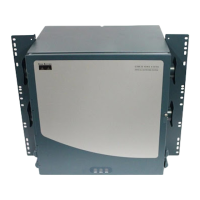20-19
Cisco ONS 15454 Procedure Guide, R5.0
March 2005
Chapter 20 DLPs A300 to A399
DLP-A329 Create a Two-Fiber BLSR Manually
Step 2 Click Create.
Step 3 In the Suggestion dialog box, click OK.
Step 4 In the Create BLSR dialog box, set the BLSR properties:
• Ring Type—Choose two-fiber.
• Ring Name—Assign a ring name. You must use the same ring name for each node in the BLSR. Any
alphanumeric character string is permissible, and upper and lower case letters can be combined. Do
not use the character string “All” in either upper or lower case letters; this is a TL1 keyword and will
be rejected. Do not choose a name that is already assigned to another BLSR.
• Node ID—Choose a Node ID from the drop-down list (0 through 31). The Node ID identifies the
node to the BLSR. Nodes in the same BLSR must have unique Node IDs.
• Reversion time—Set the amount of time that will pass before the traffic reverts to the original
working path. The default is 5 minutes. All nodes in a BLSR must have the same reversion time
setting.
• West Line—Assign the west BLSR port for the node from the drop-down list.
Note The east and west ports must match the fiber connections and DCC terminations set up in
the “NTP-A40 Provision BLSR Nodes” procedure on page 5-10.
• East Line—Assign the east BLSR port for the node from the drop-down list.
Step 5 Click OK.
Note Some or all of the following alarms will appear until all the BLSR nodes are provisioned: E-W
MISMATCH, RING MISMATCH, APSCIMP, APSDFLTK, and BLSROSYNC. The alarms will
clear after you configure all the nodes in the BLSR.
Step 6 From the View menu, choose Go to Other Node.
Step 7 In the Select Node dialog box, choose the next node that you want to add to the BLSR.
Step 8 Repeat Steps 1 through 7 at each node that you want to add to the BLSR. When all nodes have been
added, continue with Step 9.
Step 9 From the View menu, choose Go to Network View. After 10 to 15 seconds, verify the following:
• A green span line appears between all BLSR nodes.
• All E-W MISMATCH, RING MISMATCH, APSCIMP, DFLTK, and BLSROSYNC alarms are
cleared.
Step 10 Return to your originating procedure (NTP).

